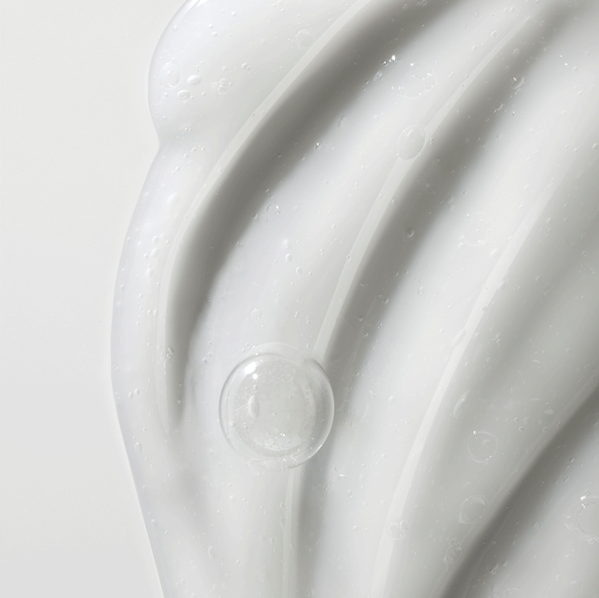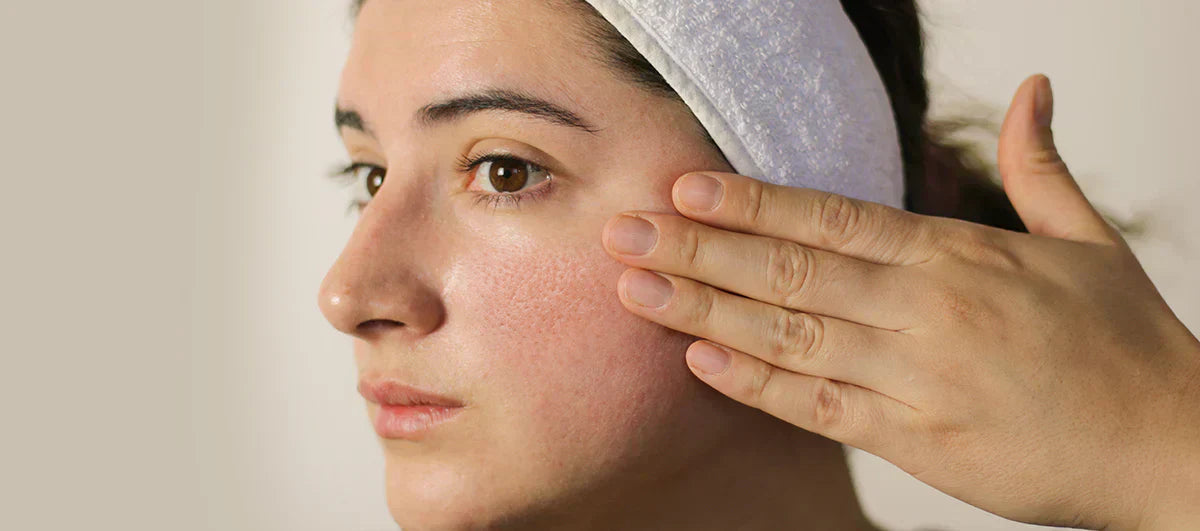Has your skin ever sent you mixed signals? Oily and prone to breakouts across your T-zone, yet dry, tight and flaky on your cheeks and jawline? If this is you, don’t worry, you are one of the millions navigating the complexities of combination skin.
This unique duality makes finding the right products (and the perfect routine) a little more challenging. Applying a mattifying product everywhere leaves your cheeks thirsty, while a rich hydrator suffocates your T-zone.
At Lighthouse, we believe the key to managing this skin type isn’t a single universal product, but a targeted skin-zoning strategy. But first, let’s explore what combination skin is.
Understanding Combination Skin

The term “combination skin” refers to a facial profile where two or more different skin types coexist simultaneously. Typically, this manifests as:
The Oily T-Zone
Your forehead, nose and chin – the T-zone – have a higher concentration of active sebaceous glands. These areas produce excess sebum, leading to shine, visibly larger pores, blackheads and potential acne breakouts.
The Dry Periphery
Your cheeks, jawline and temples, however, produce far less oil. These areas are prone to dryness, tightness, flaking and a compromised skin barrier.
The challenge lies in the fact that products suitable for the T-zone (like mattifying acids or oil-control gels) are often too harsh and dehydrating for the cheeks. Conversely, rich creams needed for the cheeks will cause congestion and breakouts in the T-zone.
Our dermatologist-backed, seven-step skincare routine for combination skin is designed to treat each area of your face precisely how it needs to be treated. In this blog, we’re going to walk you through how to layer high-performance cleansers, serums, moisturisers and sunscreens to achieve a harmonious, balanced and radiant complexion.
It’s time to stop treating your face as one uniform canvas and start giving it the personalized attention it deserves.
The Lighthouse 7-Step Skin-Zoning Routine
This routine is structured for both morning and evening, with minor adjustments. The core principle remains consistent: apply a lightweight, balancing formula to your oily zones (forehead, nose, chin) and a richer, barrier-supporting formula to your dry zones (cheeks, perimeter).
Step 1: The Intelligent Double Cleanse (Evening)
The foundation of any great routine is meticulous cleansing. For combination skin, the goal is to purify the oily T-zone without stripping the drier cheeks.

-
Evening: begin with a gentle exfoliating cleanse, such as this one from Revision. This first cleanse dissolves sunscreen, makeup and environmental pollutants without disrupting the skin barrier. Follow up with a gentle, hydrating second cleanse to ensure pores are completely clear and ready to absorb treatment. Our go-to is the Toleriane Purifying Foaming Facial Wash, a gentle wash-off cleanser that frees pores from dirt, makeup and impurities, leaving skin feeling clean, fresh and comfortable.
-
Morning: A simple rinse with tepid water is usually sufficient to refresh the skin without causing unnecessary dryness.
Why it matters: a thorough but gentle double evening cleanse ensures your congested zones are decongested, preventing breakouts while keeping the rest of your face calm.
Step 2: Balance And Prep With A Gentle Toner
Immediately after cleansing, while the skin is still slightly damp, apply an alcohol-free, hydrating essence or toner. Avoid harsh astringents, which can trigger compensatory oil production in your T-zone and irritate your cheeks.
Look for nourishing ingredients like ceramides and soothing botanicals and press the product gently into the skin. This step introduces vital hydration and prepares your entire complexion to better absorb the targeted serums that follow. Think of it as opening the cellular highways of your skin.
Step 3 & 4: The Skin-Zoning Serum Strategy (Targeted Treatment)
This is where the power of skin-zoning truly comes into play. You will use two different serums simultaneously to address the contrasting needs of your skin.
Step 3: Clarify The T-Zone
On your forehead, nose, and chin (the oilier T-zone), apply a small amount of a clarifying, decongesting serum. Look for products that contain a gentle percentage of salicylic acid (BHA), which works deep within the pore lining to dissolve excess sebum, minimize blackheads and prevent future congestion. Keep this serum strictly to the areas where you experience oiliness and breakouts.
Step 4: Hydrate And Barrier Repair The Cheeks
For your drier cheeks, orbital bone and perimeter, focus on strengthening the moisture barrier and boosting hydration. Apply a few drops of Vitamin C Serum 10% from La Roche-Posay or Hyalu B5 Hyaluronic Acid Serum to provide deep, lasting hydration and reduce the visible signs of irritation.
Keep this serum strictly to the areas where you experience dryness or tightness.
Why it matters: by strategically applying different active ingredients, you avoid drying out your cheeks with clarifying acids and prevent congestion in your T-zone with rich hydrators. You’re giving your skin exactly what it needs, where it needs it.

Step 5: The Dual Moisturizer Approach
Just like your serums, your moisturizer application requires the strategic use of two formulas. This step seals in the benefits of your serums and locks in hydration.
-
For the T-Zone: apply a tiny amount of the Toleriane Double Repair Matte Moisturizer. This is a double-action gel that provides double the repair, giving all-day, shine-free hydration and restoring skin after just one hour. Perfect for areas prone to midday oil-slicking.

-
For the Cheeks and Perimeter: Use the Toleriane Dermallergo Ultra Soothing Repair Moisturizer: A clinically proven cream that nourishes and soothes allergy-prone, ultra-sensitive skin, effectively hydrating and reducing redness, dryness, tightness and itchiness.
Blend the two moisturizers seamlessly at the border of your T-zone and cheeks. This dual approach is transformative for a balanced complexion.

Step 6: Eye Care And Targeted Spot Treatment
This optional step addresses specific, small-area concerns. Our go-to products are the PRO Firming Eye Serum, from Restorsea, designed to transform your under-eye area, leaving you with noticeably brighter eyes. For breakouts, Effaclar Duo from La Roche-Posay is a winner.
-
Eye Cream: gently tap your chosen eye cream or serum around the orbital bone.
-
Spot Treatments (evening): if needed, dab a non-drying spot treatment only on active blemishes in the T-zone.

Step 7: The Non-Negotiable Broad-Spectrum SPF (Morning Only)
The final and most crucial step of your morning routine is sun protection. UV damage degrades collagen and elastin, leading to uneven tone and can exacerbate both oiliness and dehydration.
Combination skin benefits most from a lightweight, broad-spectrum, non-comedogenic formula. We love UV Clear SPF 46 Untinted Sunscreen from EltaMD, a versatile daily sunscreen, formulated with high-purity niacinamide (vitamin B3) to reduce the appearance of blemishes and discoloration.
Apply generously across the entire face, neck and chest 15 minutes before sun exposure. This step is a cornerstone of long-term skin health.

Unlock Your Balanced Glow
Achieving optimal results for combination skin is about precision, and our dermatologist-approved skincare for combination skin is designed to hydrate dry areas while controlling excess oil, without disrupting the skin’s natural barrier.
The days of struggling to manage your conflicting skin type are over. The 7-Step Skin-Zoning Routine is the most effective skincare routine for combination skin because it acknowledges the duality of your complexion. By embracing the power of targeted application and layering using our dermatologist-approved skincare products, you can finally achieve that harmonious, balanced and healthy glow you’ve been seeking.
Explore the full collection today and start your journey towards a consistent routine that maintains equilibrium, prevents breakouts, and promotes overall skin health.





